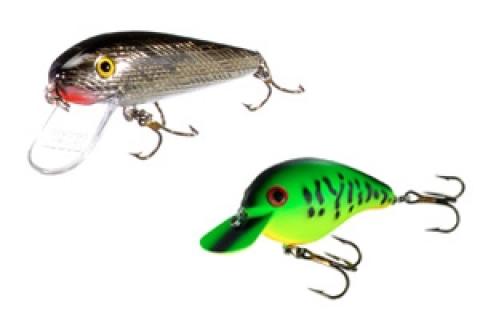
Rebel Minnow
 |
| The Rebel Minnow is an excellent lure for bass and stripers schooling on the surface. |
When the Rapala lure burst upon the U.S. fishing scene over 50 years ago, it was an instant success — thanks partly to an article in Life magazine that featured the late actress Marilyn Monroe on the cover. But George Perrin was a plastics man and figured he could make an effective, thin-minnow lure out of this material that would be more durable, less expensive than wood and cast farther. As owner of the Plastics Research and Development Company (PRADCO), he had the perfect laboratory to create such a product.
After first carving a wooden plug to his satisfaction, he then created a mold of it and began manufacturing the lures out of plastic in the early 1960s. That was the beginning of what today has become one of the largest lure manufacturing companies in the world, PRADCO. The original Rebel Minnow was 4 1/2 inches, but today the lure is sold in a wide variety of sizes, in jointed and un-jointed versions, in dozens of color patterns.
It's also now offered in a Rebel Value Minnow configuration, which lacks the intricate scale texture of the top-line models but still is a potent fish-catcher.
While it first gained popularity as a largemouth lure, as stripers became more and more readily available through widespread stocking, anglers also began turning to the Rebel for those transplants from the sea. In fact, a 5 1/2 inch Rebel Minnow caught a former world record freshwater striper of 59 pounds in the Colorado River. Not to be outdone, saltwater striper fishermen began tossing the new lure for Atlantic Ocean bass and a 79-pounder was caught, establishing a record at that time for saltwater stripers as well.
Tactics
The Rebel is an excellent lure for bass and stripers schooling on the surface or pike, pickerel and bass near shoreline cover. Try a steady moderate retrieve or V-wake the lure on top so it creates an indention on the surface but does not dive. Also try twitching the lure near cover such as rocks, docks, logjams, flooded timber and vegetation. You can also use this lure for downrigger trolling for trout, salmon and walleyes in deep water or shallow trolling when fish are near the surface.
Cordell Big O
 |
| Cast the Cordell Big O over points, humps, rock piles and submerged weed beds in lakes. |
In 1967, Tennessean Fred Young began carving pudgy diving plugs from a block of balsa with a short lip on them. Thus was born the first fat-bodied crankbait. Naming the lure the Big O, after his brother, Otis, Fred gave the plugs to him to test. He not only tested them, he won several tournaments with the new bait, creating a huge demand for the new offering.
Lure maker Cotton Cordell met Fred and came to an agreement to manufacture the new sensational plugs — but out of plastic, instead of wood. The lure was an immediate hit, selling over a million in the first year and spawning a host of imitators. Now made in several sizes, the Big O continues to sell well and catch lots of bass, plus pike, walleyes and trout.
Tactics
Cast over points, humps, rock piles and submerged weed beds in lakes and probe pools and eddies in rivers. Try both slow and steady and fast and erratic retrieves. Bumping the lure across the bottom like a scurrying crayfish is also a deadly tactic.
- 5378 views

